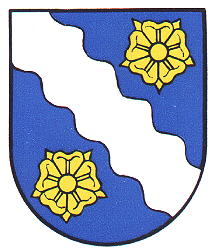Steinbach (Külsheim): Difference between revisions
Jump to navigation
Jump to search
Knorrepoes (talk | contribs) m (Text replace - "|width="15%"|50 px|right |}" to "|width="15%"|50 px|right |}<seo title="Wappen, Gemeindewappen" />") |
Knorrepoes (talk | contribs) m (Text replace - "[[Literature" to "{{media}} [[Literature") |
||
| Line 21: | Line 21: | ||
The silver bend is a canting symbol, -bach means brook or stream. The two roses and the colours are taken from the historical arms of the Counts of Wertheim, to whom the village belonged from 1430-1806. Before 1908 the village had no arms and used only a village seal with the name of the municipality. | The silver bend is a canting symbol, -bach means brook or stream. The two roses and the colours are taken from the historical arms of the Counts of Wertheim, to whom the village belonged from 1430-1806. Before 1908 the village had no arms and used only a village seal with the name of the municipality. | ||
{{media}} | |||
[[Literature]] : Zier and Kastner, 1967 | [[Literature]] : Zier and Kastner, 1967 | ||
Revision as of 06:17, 9 July 2014
| Heraldry of the World Civic heraldry of Germany - Deutsche Wappen (Gemeindewappen/Kreiswappen) |
STEINBACH
State : Baden-Württemberg
District (Kreis) : Main-Tauber Kreis (until 1973 Tauberbischofsheim)
Incorporated into : 1975 Külsheim
Official blazon
In Blau ein silberner Schrägbalken, begleitet von zwei goldenen Rosen.
Origin/meaning
The arms were designed in 1908 and adopted by the local council on January 18, 1909.
The silver bend is a canting symbol, -bach means brook or stream. The two roses and the colours are taken from the historical arms of the Counts of Wertheim, to whom the village belonged from 1430-1806. Before 1908 the village had no arms and used only a village seal with the name of the municipality.
Contact and Support
Partners:
Your logo here ?
Contact us
© since 1995, Heraldry of the World, Ralf Hartemink 
Index of the site
Literature : Zier and Kastner, 1967











